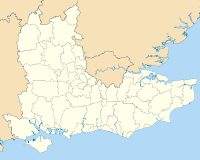User:OldSpot61/Sandbox/ESussex
East Sussex | |
|---|---|
 | |
| Sovereign state | United Kingdom |
| Constituent country | England |
| Region | South East England |
| Established | Historic |
| Time zone | UTC+0 (GMT) |
| • Summer (DST) | UTC+1 (BST) |
| Ceremonial county | |
| Area | 1,791 km2 (692 sq mi) |
| • Rank | 33rd of 48 |
| Population (2022)[1] | 828,685 |
| • Rank | 30th of 48 |
| Density | 463/km2 (1,200/sq mi) |
East Sussex (/ˈsʌsɪks/) is a county in South East England. It is bordered by the counties of Kent, Surrey, Brighton and Hove and West Sussex, and to the south by the English Channel.
History
[edit]See main article:History of Sussex
East Sussex is part of the ancient kingdom of the South Saxons, who established themselves there in the fifth century AD, after the departure of the Romans, although the area had been populated for many thousands of years before then. Archaeological remains are plentiful, especially in the upland areas. The area's position on the coast has also meant that there were many invaders, including the Romans and later the Normans. Earlier industries have included fishing, iron-making, and the wool trade, all of which have declined, or lost completely.
Governance
[edit]The ancient kingdom of Sussex has had two separate county administrations since the 12th century, with the county town of the eastern division being Lewes.[2] This situation was formalised by Parliament in 1865, and the two parts were given distinct elected county councils in 1889 under the Local Government Act 1888. In East Sussex there were also three self-administered county boroughs: Brighton, Eastbourne and Hastings.
snip snip snip
50°56′06″N 0°14′02″E / 50.935°N 0.234°E
References
[edit]- ^ "Mid-2022 population estimates by Lieutenancy areas (as at 1997) for England and Wales". Office for National Statistics. 24 June 2024. Retrieved 26 June 2024.
- ^ [1]

